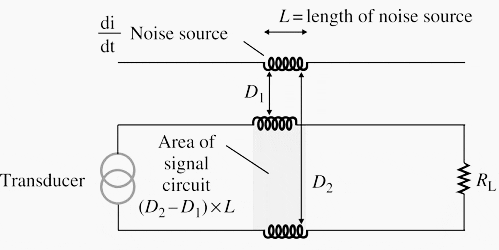Electromagnetic induction and RFI
In previous part of this technical article, I wrote about electrical noise occurs or is transmitted into a signal cable system in the following four ways:- Galvanic (direct electrical contact) – part 1
- Electrostatic coupling – part 1
- Electromagnetic induction
- Radio frequency interference (RFI)

3. Magnetic or inductive coupling
This depends on the rate of change of the noise current and the mutual inductance between the noise system and the signal wires.Expressed slightly differently, the degree of noise induced by magnetic coupling will depend on the:
- Magnitude of the noise current
- Frequency of the noise current
- Area enclosed by the signal wires (through which the noise current magnetic flux cuts)
- Inverse of the distance from the disturbing noise source to the signal wires.

Figure 1 – Magnetic coupling
The easiest way of reducing the noise voltage caused by magnetic coupling is to twist the signal conductors. This results in lower noise due to the smaller area for each loop.
This means less
magnetic flux to cut through the loop and consequently a lower
induced noise voltage. In addition, the noise voltage that is induced in
each loop tends to cancel out the noise voltages from the next sequential loop.
Hence
an even number of loops will tend to have the noise voltages canceling
each other out. It is assumed that the noise voltage is induced in equal
magnitudes in each signal wire due to the twisting of the wires giving a
similar separation distance from the noise voltage (see Figure 3).
Figure 3 – Twisting of wires to reduce magnetic coupling
The second approach is to use a magnetic shield around the signal wires (refer Figure 4).
The magnetic flux generated from the noise currents induces small eddy currents in the magnetic shield. These eddy currents then create an opposing magnetic flux Φ1 to the original flux Φ2. This means a lesser flux (Φ2 − Φ1) reaches our circuit!

Figure 4 – Use of magnetic shield to reduce magnetic coupling
Note: The magnetic shield does not require earthing. It works merely by being present. High-permeability steel makes best magnetic shields for special applications. However, galvanized steel conduit makes a quite effective shield.
No comments:
Post a Comment